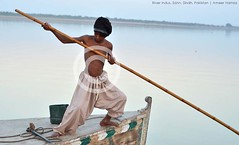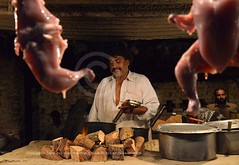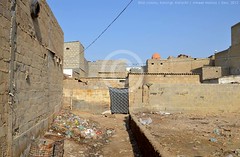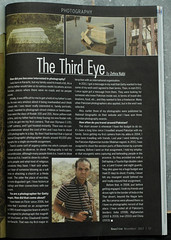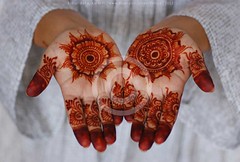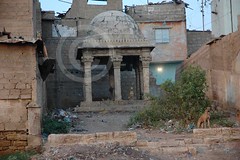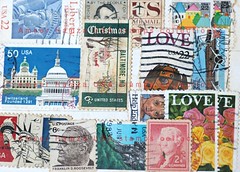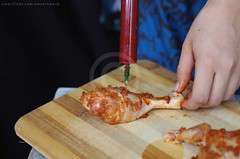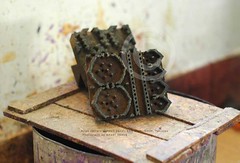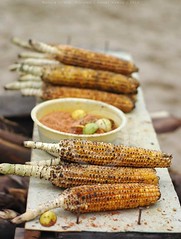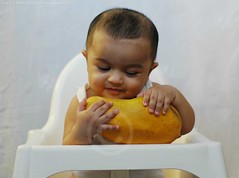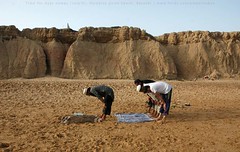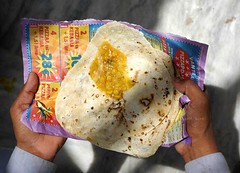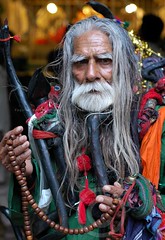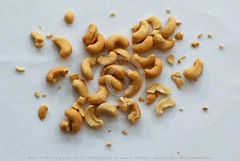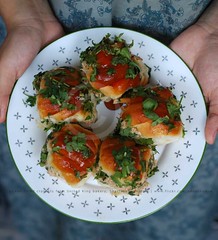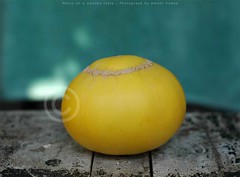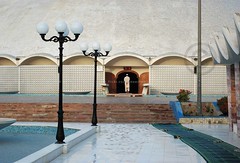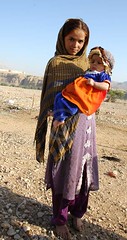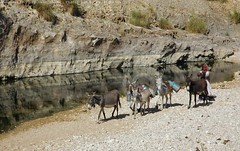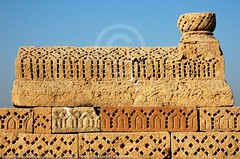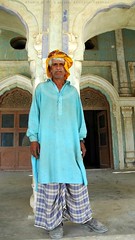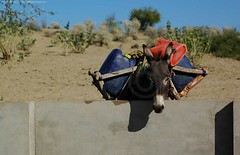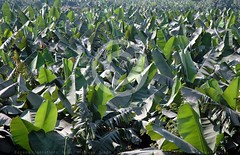On the edge of River Indus at Sann I found this young boy pushing his boat and himself to the safety of ground. For years I had wanted this type of frame: Single boy, preferably without shirt to show poverty as well as freedom; a single boat in the frame and low light conditions. It was a moment I wanted and I got.
[Shot on 23rd Dec. 2012 with Nikon D7000.
Thursday, December 27, 2012
Wednesday, December 26, 2012
Dhaba, Sann bus stop, Highway
Via Flickr:
Making chai (tea) for customers at his highway dhaba, Sann.
Chai: Rs.20 / cup
Making chai (tea) for customers at his highway dhaba, Sann.
Chai: Rs.20 / cup
Sunday, December 16, 2012
Dangerous work, Karachi
Via Flickr:
A "pranch" fixer balances himself on a construction site at 12th floor without any safety concerns whatsover. The construction industry in Pakistan is lax when it comes to providing proper facilities to labours, causing many deaths annually. As these sites are never checked by authorities concerned, builders and contractors keep no measures in place.
A "pranch" fixer balances himself on a construction site at 12th floor without any safety concerns whatsover. The construction industry in Pakistan is lax when it comes to providing proper facilities to labours, causing many deaths annually. As these sites are never checked by authorities concerned, builders and contractors keep no measures in place.
Bilal colony, Korangi
Via Flickr:
I visited Bilal Colony today (16th Dec 2012) to see for myself the living conditions there. As expected, much of the area cannot be photographed because Pashtuns traditionally shy away from photographers for fear that their women may be photographed.
Another reason is the illegal drugs and liqor business which is rampant in these areas. Off course everything happens under the watchful eyes of Police. However, recently an operation was conducted by Police and agencies and many drug peddlers and target killers were caught red handed.
I visited Bilal Colony today (16th Dec 2012) to see for myself the living conditions there. As expected, much of the area cannot be photographed because Pashtuns traditionally shy away from photographers for fear that their women may be photographed.
Another reason is the illegal drugs and liqor business which is rampant in these areas. Off course everything happens under the watchful eyes of Police. However, recently an operation was conducted by Police and agencies and many drug peddlers and target killers were caught red handed.
Friday, November 23, 2012
PUBLISHED: Interview in Newsline Nov. 2012
PUBLISHED by one of the leading political / social monthly magazine in the country. This is a special issue dedicated to "Politics of Religion". Read it here:
Ameer Hamza has traveled all over Pakistan, capturing different sides of the country with his camera. Newsline spoke to the talented photographer to find out how he got started and we have culled some images from his portfolio that reflect the rich and varied expressions of faith in Pakistan.
How did you become interested in photography?
I was born in Karachi, but my family used to travel a lot. As a child my father would take us to various exotic locations across Pakistan, places where there were no roads and no people around.
Initially, it was difficult for me to get a hold of my father’s camera. He was very anxious about it being manhandled and I think I always did. I was never really interested in family portraits. Instead, I wanted to photograph street children or landscapes. Those were the days of Kodak 100 and 200, those yellow-coated films, and my father had to keep buying me new Kodak rolls. In 2004, he got me my first camera. That was Olympus C-120, a 2-MP camera, and I got hooked instantly. There was no concern whatsoever about the cost of film and I was free to shoot 1,000 photographs in a day. By then I had learned that a typical National Geographic photographer shoots around 40,000 photographs for a single six-month assignment.
There’s some sort of urgency within me which compels me to move around, to observe, to shoot. Photography is not my main profession, although many people think it is. I want to show Pakistan as it is. I want to show its culture and its people and what kind of religious inclinations they have. I feel sick whenever I hear of someone blowing up a Sufi shrine or attacking a church or a Hindu temple. The older the place of worship, the more disgusted I get. I love historical buildings and their connections with our present.
You are a photographer for Getty Images. How did that come about?
I have been on Flickr since 2006, but before that I worked on an assignment for CNN’s travel magazine team in which I was assigned to photograph the magnificent structures at the Chaukandi tombs near Karachi. That was my first major interaction with an international organisation.
In 2011, I got a message in my mail that Getty wanted to buy some of my work and I agreed to their terms. Then, in mid-2011, I once again got a message from them. They were looking for someone who knew Pakistan inside out, in terms of travel destinations, food, etc., and they wanted to hire a freelancer. Many other Pakistani photographers also applied, but in the end I was selected.
Also, earlier three of my photographs were published by National Geographic on their website and I have won three Guardian photography awards.
How often do you travel around Pakistan?
The short answer is whenever I have the budget to do so. It’s been a long time since I travelled around Pakistan with my family. Since getting my first camera from my abbu in 2004, I have been travelling with friends. Last year I went trekking on the Pakistan-Afghanistan border (Wakhan region). In 2010, I was assigned to shoot the western parts of Balochistan by a private company. Before I went on that assignment, I told my employer that insurgents were capturing and beheading people in the province. So they provided me with a Dell laptop, a Toyota Vigo double cabin car, a Land Cruiser and eight guards. They also gave me a huge budget and I had 21 days to shoot. Frankly, I never felt any insurgent would behead me and I really enjoyed that assignment.
Before that, in 2008, just before getting engaged, I took my friends and drove right to the border of India in the Thar desert, beyond the Nagar temple. No cameras were allowed there so I have no photographic record of that place. I have visited all of Pakistan’s borders: India (2008), Afghanistan (2002 & 2010), Iran (2010) and China (2003).
Ameer Hamza's Photo gallery
Ameer Hamza has traveled all over Pakistan, capturing different sides of the country with his camera. Newsline spoke to the talented photographer to find out how he got started and we have culled some images from his portfolio that reflect the rich and varied expressions of faith in Pakistan.
How did you become interested in photography?
I was born in Karachi, but my family used to travel a lot. As a child my father would take us to various exotic locations across Pakistan, places where there were no roads and no people around.
Initially, it was difficult for me to get a hold of my father’s camera. He was very anxious about it being manhandled and I think I always did. I was never really interested in family portraits. Instead, I wanted to photograph street children or landscapes. Those were the days of Kodak 100 and 200, those yellow-coated films, and my father had to keep buying me new Kodak rolls. In 2004, he got me my first camera. That was Olympus C-120, a 2-MP camera, and I got hooked instantly. There was no concern whatsoever about the cost of film and I was free to shoot 1,000 photographs in a day. By then I had learned that a typical National Geographic photographer shoots around 40,000 photographs for a single six-month assignment.
There’s some sort of urgency within me which compels me to move around, to observe, to shoot. Photography is not my main profession, although many people think it is. I want to show Pakistan as it is. I want to show its culture and its people and what kind of religious inclinations they have. I feel sick whenever I hear of someone blowing up a Sufi shrine or attacking a church or a Hindu temple. The older the place of worship, the more disgusted I get. I love historical buildings and their connections with our present.
You are a photographer for Getty Images. How did that come about?
I have been on Flickr since 2006, but before that I worked on an assignment for CNN’s travel magazine team in which I was assigned to photograph the magnificent structures at the Chaukandi tombs near Karachi. That was my first major interaction with an international organisation.
In 2011, I got a message in my mail that Getty wanted to buy some of my work and I agreed to their terms. Then, in mid-2011, I once again got a message from them. They were looking for someone who knew Pakistan inside out, in terms of travel destinations, food, etc., and they wanted to hire a freelancer. Many other Pakistani photographers also applied, but in the end I was selected.
Also, earlier three of my photographs were published by National Geographic on their website and I have won three Guardian photography awards.
How often do you travel around Pakistan?
The short answer is whenever I have the budget to do so. It’s been a long time since I travelled around Pakistan with my family. Since getting my first camera from my abbu in 2004, I have been travelling with friends. Last year I went trekking on the Pakistan-Afghanistan border (Wakhan region). In 2010, I was assigned to shoot the western parts of Balochistan by a private company. Before I went on that assignment, I told my employer that insurgents were capturing and beheading people in the province. So they provided me with a Dell laptop, a Toyota Vigo double cabin car, a Land Cruiser and eight guards. They also gave me a huge budget and I had 21 days to shoot. Frankly, I never felt any insurgent would behead me and I really enjoyed that assignment.
Before that, in 2008, just before getting engaged, I took my friends and drove right to the border of India in the Thar desert, beyond the Nagar temple. No cameras were allowed there so I have no photographic record of that place. I have visited all of Pakistan’s borders: India (2008), Afghanistan (2002 & 2010), Iran (2010) and China (2003).
Ameer Hamza's Photo gallery
Saturday, October 27, 2012
Eid Mehndi, Karachi
Eid Mubarak to all Muslims.
Mehndi patterns displayed by a Pakistani girl in Karachi, Pakistan.
Mehndi patterns displayed by a Pakistani girl in Karachi, Pakistan.
Thursday, October 11, 2012
Tomb of Phyllis Louise Lawrence, Gora Qabristan, Karachi
The white-domed tomb of Phyllis Louise Lawrence, nee Napier, the first wife of Sir Henry Staveley Lawrence (Collector of Karachi). The Lawrence couple were married in 1899 and had three children before Phyllis was killed in a carriage accident in Karachi on 30 June 1912. Karachi, Sind, British India.
I was able to shoot this photograph early morning of 24th Dec, 2006, when I visited the place with my mother. It saddens me that the place around the tomb is now all vandalized and captured by land mafia. I was told by a Christian at the cemetery that this area was taken up by Muslim refugees from India after partition. Somehow this tomb survived.
There's an interesting story about this woman in the book written on Karachi (a compilation) by Asif Farukki.
I was able to shoot this photograph early morning of 24th Dec, 2006, when I visited the place with my mother. It saddens me that the place around the tomb is now all vandalized and captured by land mafia. I was told by a Christian at the cemetery that this area was taken up by Muslim refugees from India after partition. Somehow this tomb survived.
There's an interesting story about this woman in the book written on Karachi (a compilation) by Asif Farukki.
Sunday, September 23, 2012
Anyone loves USA?
Via Flickr:
Anti-US and Anti-Israel protests across much of Muslim world including Pakistan prompted me to get my collection of stamps out and hunt for USA stamps. Here are some of them. After so many years, they still look colourful and bring out memories etched somewhere back on my mind.
I love these stamps but do I love USA?
Shot with Tamron 90mm 2.8 lens.
Anti-US and Anti-Israel protests across much of Muslim world including Pakistan prompted me to get my collection of stamps out and hunt for USA stamps. Here are some of them. After so many years, they still look colourful and bring out memories etched somewhere back on my mind.
I love these stamps but do I love USA?
Shot with Tamron 90mm 2.8 lens.
Tuesday, August 7, 2012
Portrait: Waterproofing labour, Karachi
This is Arshad Khan, my waterproofing labour and Afridi pathan. Afridi pathans are numerous in Pakistan and are considered most handsome among all Pashtuns. They are proud and strong and hard working. I suspect that many of them now living in Karachi have become quite lazy - but not Arshad.
For Roof, Basement and Bathroom waterproofing in Pakistan please contact Ameer Hamza at 0301-2228210 or email at ameer.great@gmail.com. You may also find details and prestigious projects completed in Pakistan here.
For Roof, Basement and Bathroom waterproofing in Pakistan please contact Ameer Hamza at 0301-2228210 or email at ameer.great@gmail.com. You may also find details and prestigious projects completed in Pakistan here.
Thursday, August 2, 2012
A chance meeting with Salman Rashid
My friend from bank, Adil Mulki, called me up two days back informing me that he just received Mr. Salman Rashid, ace travel writer of Pakistan, in his office and that he was willing to have Iftari with us. I was surprised to say the least. I agreed without thinking.
Yesterday (Thursday) Adil, myself and Danial Shah, my friend from Flickr, took Salman to Sajjad's restaurant in Phase 8 DHA, Karachi. It's a pleasant, sea-side restaurant with Arabian Sea lapping next to its wooden columns. It's a place where you take your friends from afar to impress. Although, I must say, the food quality has progressively declined in recent months. More Pakistanis are now flocking to eat sub-standard food there.
Salman was in a pleasant mood and was talking as always. We were also in quite a pleasant mood despite the fact that we'd reached the place just 2 minutes before breaking of fast. Salman .... (censored) .... is a man much given to travel and history and discipline. He is a learned man and that is shown by the quality of his articles. Even the basic ones carry a certain weight and a historical background wherever required. His emphasis on correctness of terminology doesn't suit the usual travel-writing world of Pakistanis where names are altered on whim and history is created by one's own pen.
Salman gave us the example of people like ..... (censored).... both of whom receive generous funds from rich Pakistanis; both are psuedo-intellectuals as per my .....(censored) understanding. For comparison read any book of Salman Rashid and then read any book penned by Tarrar sb. If you are into fake ideas, fairies and fantasies, then Tarrar is for you (my idea, not Salman's); if you are into genuine historical perspective and travel writing then Salman is for you. There is no doubt that he is a top travel writer of our generation in our country. And I don't see anyone else approaching his class anytime soon, which is sad.
During our Iftari + Dinner meeting I found Salman very helpful, very keen to learn new things and new routes and very very .... (censored). He wakes up at 5 AM or even earlier and sleeps early too, a rather rare attitude among urban Pakistanis. And he reads a lot. He emphasized that we must read original sources as much as we can. He named a few I knew. He told us how and why he left Army, then went to Siemens Pakistan, then left that job and became a full time vagabond, a hard life to live. He still lives and talks like that and he is still quite energetic. Travellers must be energetic themselves; he is not surely an arm-chair type of a person and loves fish immensely too so we ordered strange-sounding fish for him which turned out tasty. Chicken Karahi wasn't that tasty, though.
All in all, I really liked meeting him and I informed him that he is the only travel writer worth reading in Pakistan. Being a humble person he just shrugged off. Though he feels ... (censored) ... those men and women who've become something in their lives and have now forgotten their poverty and their background. He again and again named .......... (censored) ................. I 100% agree.
When in Lahore, I will now do two things: Eat fish at Salman's house and avoid meeting Tarrar sahib!
Few articles by Salman Rashid here and here.
Yesterday (Thursday) Adil, myself and Danial Shah, my friend from Flickr, took Salman to Sajjad's restaurant in Phase 8 DHA, Karachi. It's a pleasant, sea-side restaurant with Arabian Sea lapping next to its wooden columns. It's a place where you take your friends from afar to impress. Although, I must say, the food quality has progressively declined in recent months. More Pakistanis are now flocking to eat sub-standard food there.
Salman was in a pleasant mood and was talking as always. We were also in quite a pleasant mood despite the fact that we'd reached the place just 2 minutes before breaking of fast. Salman .... (censored) .... is a man much given to travel and history and discipline. He is a learned man and that is shown by the quality of his articles. Even the basic ones carry a certain weight and a historical background wherever required. His emphasis on correctness of terminology doesn't suit the usual travel-writing world of Pakistanis where names are altered on whim and history is created by one's own pen.
Salman gave us the example of people like ..... (censored).... both of whom receive generous funds from rich Pakistanis; both are psuedo-intellectuals as per my .....(censored) understanding. For comparison read any book of Salman Rashid and then read any book penned by Tarrar sb. If you are into fake ideas, fairies and fantasies, then Tarrar is for you (my idea, not Salman's); if you are into genuine historical perspective and travel writing then Salman is for you. There is no doubt that he is a top travel writer of our generation in our country. And I don't see anyone else approaching his class anytime soon, which is sad.
During our Iftari + Dinner meeting I found Salman very helpful, very keen to learn new things and new routes and very very .... (censored). He wakes up at 5 AM or even earlier and sleeps early too, a rather rare attitude among urban Pakistanis. And he reads a lot. He emphasized that we must read original sources as much as we can. He named a few I knew. He told us how and why he left Army, then went to Siemens Pakistan, then left that job and became a full time vagabond, a hard life to live. He still lives and talks like that and he is still quite energetic. Travellers must be energetic themselves; he is not surely an arm-chair type of a person and loves fish immensely too so we ordered strange-sounding fish for him which turned out tasty. Chicken Karahi wasn't that tasty, though.
All in all, I really liked meeting him and I informed him that he is the only travel writer worth reading in Pakistan. Being a humble person he just shrugged off. Though he feels ... (censored) ... those men and women who've become something in their lives and have now forgotten their poverty and their background. He again and again named .......... (censored) ................. I 100% agree.
When in Lahore, I will now do two things: Eat fish at Salman's house and avoid meeting Tarrar sahib!
Few articles by Salman Rashid here and here.
Tuesday, July 24, 2012
Injecting chicken with masala
My sister demonstrates to me how yummy masala is injected directly into the leg piece of the chicken. This she called Al-Baik chicken and was served with fries and a yummy sauce containing olive oil. A bit heavy too.
Thursday, July 19, 2012
River Indus, Sehwan Sharif
The Indus River (Sanskrit: सिन्धु Sindhu; Urdu: دریائے سندھ Daryā-e Sindh; Hindi: सिन्धु नदी Sindhu; Sindhi: سنڌو Sindhu; Punjabi: سندھ Sindh; Gujarati: સિંધુ નદી Sindhu; Pashto: اباسين Abāsin "Father of Rivers"; Persian: رود سند Rūd-e Sind; Arabic: السند Al-Sind; Tibetan: སེང་གེ།་གཙང་པོ Sênggê Zangbo "Lion River"; Greek: Ινδός Indós; Turki: Nilab) is a major river which flows through Pakistan. It also has courses through western Tibet (in China) and Northern India.
Originating in the Tibetan plateau in the vicinity of Lake Mansarovar, the river runs a course through the Ladakh region of Jammu and Kashmir, Gilgit, Baltistan and flows through Pakistan in a southerly direction along the entire length of Pakistan to merge into the Arabian Sea near the port city of Karachi in Sindh. The total length of the river is 3,180 km (1,980 mi). It is Pakistan's longest river.
The river has a total drainage area exceeding 1,165,000 km2 (450,000 sq mi). Its estimated annual flow stands at around 207 km3 (50 cu mi), making it the twenty-first largest river in the world in terms of annual flow. Zanskar is its left bank tributary in Ladakh. In the plains, its left bank tributary is Chenab which itself has four major tributaries, namely, Jhelum, Ravi, Beas and Satluj. Its principal right bank tributaries are Shyok, Gilgit, Kabul, Gomal and Kurram. Beginning at the heights of the world in a spring and fed with glaciers and rivers in the Himalayas, the river supports ecosystems of temperate forests, plains and arid countryside.
The Indus forms the delta of Pakistan mentioned in the Vedic Rigveda as Sapta Sindhu and the Iranic Zend Avesta as Hapta Hindu (both sets of terms meaning Seven Rivers). The river has been a source of wonder during the Classical Period. King Darius of Persia sent Scylax of Caryanda to explore the river in 510 BCE.
More on this great river:
http://en.wikipedia.org/wiki/Indus_River
Originating in the Tibetan plateau in the vicinity of Lake Mansarovar, the river runs a course through the Ladakh region of Jammu and Kashmir, Gilgit, Baltistan and flows through Pakistan in a southerly direction along the entire length of Pakistan to merge into the Arabian Sea near the port city of Karachi in Sindh. The total length of the river is 3,180 km (1,980 mi). It is Pakistan's longest river.
The river has a total drainage area exceeding 1,165,000 km2 (450,000 sq mi). Its estimated annual flow stands at around 207 km3 (50 cu mi), making it the twenty-first largest river in the world in terms of annual flow. Zanskar is its left bank tributary in Ladakh. In the plains, its left bank tributary is Chenab which itself has four major tributaries, namely, Jhelum, Ravi, Beas and Satluj. Its principal right bank tributaries are Shyok, Gilgit, Kabul, Gomal and Kurram. Beginning at the heights of the world in a spring and fed with glaciers and rivers in the Himalayas, the river supports ecosystems of temperate forests, plains and arid countryside.
The Indus forms the delta of Pakistan mentioned in the Vedic Rigveda as Sapta Sindhu and the Iranic Zend Avesta as Hapta Hindu (both sets of terms meaning Seven Rivers). The river has been a source of wonder during the Classical Period. King Darius of Persia sent Scylax of Caryanda to explore the river in 510 BCE.
More on this great river:
http://en.wikipedia.org/wiki/Indus_River
Wednesday, July 18, 2012
Stamping patterns on Ajrak, Bhit Shah
Via Flickr:
Ajrak (Sindhi: اجرڪ) is a name given to a unique form of blockprinted shawls and tiles found in Sindh, Pakistan. These shawls display special designs and patterns made using block printing by stamps. Common colours used while making these patterns may include but are not limited to blue, red, black, yellow and green. Over the years, ajraks have become a symbol of the Sindhi culture and traditions.
From wikipedia.
Ajrak (Sindhi: اجرڪ) is a name given to a unique form of blockprinted shawls and tiles found in Sindh, Pakistan. These shawls display special designs and patterns made using block printing by stamps. Common colours used while making these patterns may include but are not limited to blue, red, black, yellow and green. Over the years, ajraks have become a symbol of the Sindhi culture and traditions.
From wikipedia.
Monday, July 16, 2012
Sunday, July 15, 2012
Corn for sale, Manora Island, Pakistan
Went today to Manora Island. That's my second visit within past 30 days. It was a wonderful weather and we were whole family + family of my cousin, Atiq Jetalsarwalla. These corns were selling for Rs.20 a piece. They were good. And they are healthy.
Monday, July 2, 2012
Aam Puri, Karachi
Via Flickr:
This is incredibly tasty mango milk shake made by my mother served with local puris. This is called Aam Puri (Mango is 'Aam' in Urdu).
For the photograph of the mango used for this milk shake, see photograph of the weighed mangoes.
This is incredibly tasty mango milk shake made by my mother served with local puris. This is called Aam Puri (Mango is 'Aam' in Urdu).
For the photograph of the mango used for this milk shake, see photograph of the weighed mangoes.
Sunday, July 1, 2012
Sunday is a fun day
My Son, Muhammad Imad Adhia, came out of his Sunday bath wrapped in his trademark towel and I couldn't just resist taking a few shots of him. This one is a lovely one.
All photographs in this series are spontaneous and only sunlight was used for lighting up the subject. Camera: Nikon D70s with 50mm 1.8.
All photographs in this series are spontaneous and only sunlight was used for lighting up the subject. Camera: Nikon D70s with 50mm 1.8.
Sindhri mangoes, Sindh, Pakistan
Via Flickr:
Mangoes cost around Rs.60 / Kg (As of 29th June, 2012 a USD is approx. Rs.94).
This weight machine was bought by my father. It is made in Republic of Ireland.
I wanted to show the beauty of our most famous mangoes and also of the machine weighing them. But I don't quite agree with the background. It is all crumpled.
Mangoes cost around Rs.60 / Kg (As of 29th June, 2012 a USD is approx. Rs.94).
This weight machine was bought by my father. It is made in Republic of Ireland.
I wanted to show the beauty of our most famous mangoes and also of the machine weighing them. But I don't quite agree with the background. It is all crumpled.
Imad with huge mango, Pakistan
My son, Muhammad Imad Adhia, grabbed this huge Sindhri mango. But he couldn't just raise it because it was too heavy for him.
Tuesday, June 12, 2012
Over loaded trucks
Via Flickr:
Pakistani trucks are a true works of art. They are often referred to as Folk or public art. These moving pieces of art have already won hearts and minds across Europe and USA by their details and originality.
I took this photograph on 26th June, 2009, while travelling to Sehwan Sharif in central Sindh province of Pakistan. There was this dust everywhere and one part of the highway was being built by steamroller and the other, paved, part was full with these typically decorated, overloaded trucks.
Pakistani trucks are a true works of art. They are often referred to as Folk or public art. These moving pieces of art have already won hearts and minds across Europe and USA by their details and originality.
I took this photograph on 26th June, 2009, while travelling to Sehwan Sharif in central Sindh province of Pakistan. There was this dust everywhere and one part of the highway was being built by steamroller and the other, paved, part was full with these typically decorated, overloaded trucks.
Wednesday, May 30, 2012
Desi snacks: Ghatia with masala and moti choor key ludoo, Karachi
Via Flickr:
Ghatia from Abdur Rasheed bhai, Ranchore lane.
(Right): Moti choor key ludoo.
Ghatia from Abdur Rasheed bhai, Ranchore lane.
(Right): Moti choor key ludoo.
Moti choor key ludoo, Karachi
Via Flickr:
From Ranchor lane, Karachi - Sukker sweets.
Address: Ghosht market, Pona Bhai tower, Ranchor Lane, Karachi, Pakistan.
From Ranchor lane, Karachi - Sukker sweets.
Address: Ghosht market, Pona Bhai tower, Ranchor Lane, Karachi, Pakistan.
Wednesday, May 23, 2012
Traditional straw items, Sehwan Sharif
I really like these traditional items made in various parts of Sindh province. In this case they are the daily use items like plates, covers, tops, decorative pieces for walls, etc. They are earthly, which means they are environment friendly; they are made from hand thus employing lots of females in the process; and they are cultural icons for Sindh, just like blue tiles from Hala or ajrak from central Sindh are.
[Image available for sale from Getty:
http://www.gettyimages.com/Search/Search.aspx?assettype=image&family=creative&artist=Ameer+Hamza]
[Image available for sale from Getty:
http://www.gettyimages.com/Search/Search.aspx?assettype=image&family=creative&artist=Ameer+Hamza]
Tuesday, May 22, 2012
Time for prayers, Karachi
Via Flickr:
Muslims pray for their Asar namaz (known as Sala'h in Arabic). Asar is the 3rd namaz among 5 daily obligatory prayers in Islam.
Paradise point beach is one of the most famous soft sand beaches of Pakistan.
Muslims pray for their Asar namaz (known as Sala'h in Arabic). Asar is the 3rd namaz among 5 daily obligatory prayers in Islam.
Paradise point beach is one of the most famous soft sand beaches of Pakistan.
Wednesday, May 2, 2012
Anti-Pakistan poster, Sehwan Sharif
Sindu Desh is the concept probably launched by late G. M Syed, leader of Sind and a very well read person. He was regarded with awe and respect by almost all Sindhis and hated by Establishment and the Punjabis for speaking out atrocities committed by them on Sindh. The issue of distribution of water and other resources troubled his entire life. His followers and many other Sindhi youth, who are disillusioned with the entire concept of Pakistan, have continued this struggle and are now openly printing these posters and pasting all over Sindh. It really surprises me how Pakistan Army and its intelligence could allow such posters?
Today, lot of mini-bombs went across Sindh province hitting apparently at ATMs. Read this report:
http://tribune.com.pk/story/372948/bombs-target-at-least-half-a-dozen-nbp-branches-in-sindh/
Today, lot of mini-bombs went across Sindh province hitting apparently at ATMs. Read this report:
http://tribune.com.pk/story/372948/bombs-target-at-least-half-a-dozen-nbp-branches-in-sindh/
Sunday, April 29, 2012
Lunghar at Sehwan Sharif, Sindh
Via Flickr:
Lunghar, or free food, is a staple at almost all the Sufi Shrines in Pakistan, India, Iran and most of the Muslim countries. It is distributed free of cost to anyone wishing to have meal. It is simply incredible that at a Shrine like this one (Hazrat Lal Shahbaz Qalandar in Sehwan Sharif, Sindh) daily thousands of cooked breads (as above) may be distributed. Rich devotees may spend over 0.5 million Pakistani rupees in a single setting, feeding virtually thousands of poor men and women. Lunghar may also be eaten by rich and well-to-do people.
Lunghar, or free food, is a staple at almost all the Sufi Shrines in Pakistan, India, Iran and most of the Muslim countries. It is distributed free of cost to anyone wishing to have meal. It is simply incredible that at a Shrine like this one (Hazrat Lal Shahbaz Qalandar in Sehwan Sharif, Sindh) daily thousands of cooked breads (as above) may be distributed. Rich devotees may spend over 0.5 million Pakistani rupees in a single setting, feeding virtually thousands of poor men and women. Lunghar may also be eaten by rich and well-to-do people.
Portrait: Faqir at Hazrat Lal Shahbaz Qalandar (RA), SIndh
Via Flickr:
I have found this Faqir whenever I have visited this most important Muslim Saint Shrine in province of Sindh, Pakistan. Faqirs or malangs, as they are known here locally, belong to a rather interesting and rare creed of men who devote themselves to Shrines or wanderings. They get food and money from devotees, as in this case. This man carries huge wooden beads and strange instruments and never begs for money. People, if they like, can give them whatever they wish to.
I have found this Faqir whenever I have visited this most important Muslim Saint Shrine in province of Sindh, Pakistan. Faqirs or malangs, as they are known here locally, belong to a rather interesting and rare creed of men who devote themselves to Shrines or wanderings. They get food and money from devotees, as in this case. This man carries huge wooden beads and strange instruments and never begs for money. People, if they like, can give them whatever they wish to.
Sunday, April 15, 2012
Kaju Katli from Mumbai, India
Via Flickr:
One of the more expensive and widely gifted items from India is this Kaju Katli made from cashews and milk. It was gifted to me by my father-in-law, who just returned from his 10-day trip to Mumbai. This Katli was made by Central Sweets (307, Bellasis Road, opp. Bombay Central RLY. Station, Mumbai - 400 008).
Recipe Ingredients
1 Kg cashew nut pieces
800gm sugar
200gm mawa (grated)
18-20 Cardamom (powered)
20-25 threads of Saffron/Kesar (soaked in milk or at least an hour)
4 cups of water
Method and garnishing here:
http://shivanigala.hubpages.com/hub/Homemade-Kaju-Katli--Indian-sweet-dessert-
One of the more expensive and widely gifted items from India is this Kaju Katli made from cashews and milk. It was gifted to me by my father-in-law, who just returned from his 10-day trip to Mumbai. This Katli was made by Central Sweets (307, Bellasis Road, opp. Bombay Central RLY. Station, Mumbai - 400 008).
Recipe Ingredients
1 Kg cashew nut pieces
800gm sugar
200gm mawa (grated)
18-20 Cardamom (powered)
20-25 threads of Saffron/Kesar (soaked in milk or at least an hour)
4 cups of water
Method and garnishing here:
http://shivanigala.hubpages.com/hub/Homemade-Kaju-Katli--Indian-sweet-dessert-
Kaju from India
Via Flickr:
Kaju (cashew nuts in English) doesn't grow here in Pakistan. Therefore, they are mostly imported from India, either directly or via Dubai. Along with Kaju Katli my father-in-law also brought these from Mumbai, India. The packing says that it's from Vadilal Champaklal & Co., Mirchi Galli, Jumma Masjid, Mumbai.
7 Health Benefits of Cashews
1) Cancer Prevention
2) Heart Health
3) Hair and Skin Health
4) Bone Health
5) Good for the Nerves
6) Prevent Gallstones
7) Weight Loss
http://www.healthdiaries.com/eatthis/7-health-benefits-of-cashews.html
Kaju (cashew nuts in English) doesn't grow here in Pakistan. Therefore, they are mostly imported from India, either directly or via Dubai. Along with Kaju Katli my father-in-law also brought these from Mumbai, India. The packing says that it's from Vadilal Champaklal & Co., Mirchi Galli, Jumma Masjid, Mumbai.
7 Health Benefits of Cashews
1) Cancer Prevention
2) Heart Health
3) Hair and Skin Health
4) Bone Health
5) Good for the Nerves
6) Prevent Gallstones
7) Weight Loss
http://www.healthdiaries.com/eatthis/7-health-benefits-of-cashews.html
Chicken croissants, Karachi
Via Flickr:
One of the best snacks you can get anywhere in Karachi. That's from United King bakery, Sharfabad, Karachi. Rate: 8 pcs for Rs.108.
One of the best snacks you can get anywhere in Karachi. That's from United King bakery, Sharfabad, Karachi. Rate: 8 pcs for Rs.108.
Saturday, April 14, 2012
Killing of Hazaras in Quetta

This is Anees-ul-Mehdi and he studied with me at Muhammad Ali Jinnah University, Karachi campus. He is a Hazara Shia, which means his ancestors are originally from Bamiyan, Afghanistan and they emigrated to Pakistan long ago amidst Pashtuns (also referred to as Pathans) in the heart of Quetta, provincial capital of Balochistan. Anees was one of the most brilliant students of our university and he could have been anywhere. His father was a prominent worker for some International agency and he was quite well-off, much better than most Hazaras and certainly better than most Pashtuns and Baloch living in the province. Like many Hazaras, however, he had come to Karachi for studies as environment in his native Quetta was very hostile for them. He used to inform me quite frequently how they hate Sunni-Pashtuns just like Shia-Hazaras were hated by them. Once - and I recall this from memory of over 8 years old - he even told me that even his dog won't speak Pashtu, the lingua franca of Pashtuns. Such hatred was not imaginable for a person like me born and bred in metropolitan Karachi but it was quite common there.
As I grew up and travelled across Pakistan I could see very clearly that Pakistan was (and still is) full of fissures. You go to Gilgit, for instance, and you will find Shias abusing Sunnis and vice versa. Recent violencep has once again brought that to the fore. Same thing is happening in Quetta where every day 6-7 Hazara-Shias are being gunned down in broad daylight. I cannot imagine that anyone could carry machine gun in a garrison town like Quetta, but that is exactly what is happening there.
Let us now first look at why this may be happening. And why across Pakistan?
Firstly, Pakistani Army had stopped NATO containers, atleast publicly, to show its anger for killing over 30 Pakistani soldiers from across Afghanistan in an air strike. We all know that much of aid for our ghairat-mand Army comes directly from US and there is no way our Army can deny this. But if you go around abusing your chief, like Pakistani public and Army are doing right now, US will surely retaliate. We know that there are hundreds of CIA agents roaming in Pakistan, supplying arms and dollars, creating un-rest and dissent in this country. I am sure this killings of Shias across Pakistan is part of a larger game being played by CIA agents to force Pakistan into accepting its conditions. Otherwise this could go on and on. First, we saw bombings across Karachi and later in many other cities. Now killings of Shias, first at KKH, then at Gilgit and now in Quetta. And possibly next targets would be smaller cities in Sindh, then Lahore and Karachi.
Pakistan has repeatedly refused to obey American demands to support its war beat against Iran. By killing Shias, and hence by shifting their loyalties towards Iran, CIA-backed Wahabbi-Pashtun militants in Quetta and in Chilas are hoping to divide our nation once again to break the stance of our civilian as well as military leadership. Already before the Siachen fiasco there were reports emanating from the Shia-dominated NLI 6 (unit of Pakistan Army for Northern borders) that if any action against killers of Shias in Chilas was not taken, they would march towards India (sic) and become part of them (sic). Thanks to ALLAH then that glacier melted, caused avalanche - although experts now believe that it wasn't an avalanche - and our borders with India were saved (assuming that many of those soldiers were preparing to march towards India to become part of that country).
I hope against hope, just like founders of this ethnically explosive country, that we can still resist CIA and MI6 and RAW agencies and pull up unity. That is only possible if our government and our officers can save precious lives, not only of majority Sunnis but also of minority groups living in Pakistan including Hindus and Shias.
Friday, April 6, 2012
Mehndi / Henna
Via Flickr:
The mehndi applied for weddings is very different from those applied for religious or social festivals like Eids or parties, etc. The wedding mehndi, besides being very expensive (b/w USD 50 - USD 300 +), is also very detailed and may easily consume over 3-4 hours of intense concentration. Even more.
The mehndi applied for weddings is very different from those applied for religious or social festivals like Eids or parties, etc. The wedding mehndi, besides being very expensive (b/w USD 50 - USD 300 +), is also very detailed and may easily consume over 3-4 hours of intense concentration. Even more.
Melon
Small, yellow melon photographed on a dirty, old stool with blue-green towel for the background. Sun light from front.
Saturday, March 31, 2012
Mullah hulwai to khopra mithai, Karachi
Via Flickr:
No one in Karachi makes a better khopra mithai (coconut sweetmeat) than Mullah Hulwai at Nazimabad chowrangi, Karachi. Running rate is Rs.400 / Kg.
No one in Karachi makes a better khopra mithai (coconut sweetmeat) than Mullah Hulwai at Nazimabad chowrangi, Karachi. Running rate is Rs.400 / Kg.
Friday, March 23, 2012
Portrait: Zikri young girl, Mubarak Village, Karachi
Unlike most Pakistanis, Baloch women dont observe purdah. Therefore, their girls and women wear beautiful attire. That is partly due to the fact that most Balochistan is dry and arid and the colourful clothes - just like in Thar and Cholistan deserts - diffuse the effect and enliven the environment.
Saturday, March 17, 2012
Main entrance and pool Tooba masjid, Karachi
Via Flickr:
Tooba masjid is located at Korangi road, Defence Housing Society, phase 1, Karachi. It is popularly regarded as having the largest free standing dome mosque in the World, with a diameter of 236 feet. The construction was started in 1966 by Macdonald Layton and Constain construction firm and was finished in 1969. It has a capacity of around 30,000 worshipers of whom 5,000 can pack inside the dome structure.
Tooba masjid is located at Korangi road, Defence Housing Society, phase 1, Karachi. It is popularly regarded as having the largest free standing dome mosque in the World, with a diameter of 236 feet. The construction was started in 1966 by Macdonald Layton and Constain construction firm and was finished in 1969. It has a capacity of around 30,000 worshipers of whom 5,000 can pack inside the dome structure.
Thursday, March 15, 2012
Fishing near Sokhtarabad, Pakistan
(Photograph shot on 17th Sep, 2011).
After we left heavy-hearted our camp site called Sokhtarabad due to cold weather and ineptitude of our group leader, Mr. Tanwir, we were advised by this man, Mr. Azizullah, that we catch some local fish by hand. So we all gathered around and saw him catch lot of small fish. He appeared very expert in his trade and had lot of fun doing it. I was impressed. This is my favorite photograph of him.
After we left heavy-hearted our camp site called Sokhtarabad due to cold weather and ineptitude of our group leader, Mr. Tanwir, we were advised by this man, Mr. Azizullah, that we catch some local fish by hand. So we all gathered around and saw him catch lot of small fish. He appeared very expert in his trade and had lot of fun doing it. I was impressed. This is my favorite photograph of him.
Wednesday, March 7, 2012
Work: Herding goats along Rannikot walls, Sindh
Via Flickr:
Rannikot is a hot, dry place to be during 8 months. The only time one can easily visit this place is between November and Feburary, after which temperatures may shoot beyond 40 C at mid day. Goats are herded in and around this fort by the local Gabol tribe of Balochistan. Rannikot skirts the Kirthar range and is a protected National Monument.
Rannikot is a hot, dry place to be during 8 months. The only time one can easily visit this place is between November and Feburary, after which temperatures may shoot beyond 40 C at mid day. Goats are herded in and around this fort by the local Gabol tribe of Balochistan. Rannikot skirts the Kirthar range and is a protected National Monument.
Portraits: Gabol children, Rannikot
Via Flickr:
Approx. 500-600 villagers live within the formidable walls of Rannikot fort (also pronounced locally as Runnikot). These people belong to Baloch tribe of Gabol and are fiercely independent. And much unlike the Sindhis around them, their women usually do not perform any purdah (i.e., they don't cover their faces from strangers). In fact, purdah system is not enforced across Balochistan province, which lies just next to this area.
Approx. 500-600 villagers live within the formidable walls of Rannikot fort (also pronounced locally as Runnikot). These people belong to Baloch tribe of Gabol and are fiercely independent. And much unlike the Sindhis around them, their women usually do not perform any purdah (i.e., they don't cover their faces from strangers). In fact, purdah system is not enforced across Balochistan province, which lies just next to this area.
Wednesday, February 22, 2012
Herding donkeys, Rannikot
Via Flickr:
I found one of the Gabol women herding water from the Runni stream under the shadows of the fort during one of my trips to Rannikot. As a photographer it is a joy to shoot such traditional people going about their age old works.
I found one of the Gabol women herding water from the Runni stream under the shadows of the fort during one of my trips to Rannikot. As a photographer it is a joy to shoot such traditional people going about their age old works.
Sunday, February 19, 2012
Chaukhandi tombs near Karachi, Pakistan
Via Flickr:
The Chaukhandi tombs are situated 29 km east of Karachi on N-5 National Highway near Landhi Town in Pakistan. The Chaukhandi tombs are remarkable for the elaborate and exquisite stone carving.
The style of architecture is typical only to the region of Sindh, and unique in that it is found nowhere else in the Islamic world. Generally, the elements are attributed to Jokhio (also spelt Jokhiya) also known as the family graveyard of Jokhio tribe, some people of Baluch tribe also buried were built between the 15th and 18th centuries.
More: en.wikipedia.org/wiki/Chaukhandi_tombs
The Chaukhandi tombs are situated 29 km east of Karachi on N-5 National Highway near Landhi Town in Pakistan. The Chaukhandi tombs are remarkable for the elaborate and exquisite stone carving.
The style of architecture is typical only to the region of Sindh, and unique in that it is found nowhere else in the Islamic world. Generally, the elements are attributed to Jokhio (also spelt Jokhiya) also known as the family graveyard of Jokhio tribe, some people of Baluch tribe also buried were built between the 15th and 18th centuries.
More: en.wikipedia.org/wiki/Chaukhandi_tombs
From the table: Vegetables
Via Flickr:
Fresh vegetables usually found in Karachi this time of the year. Tomato, ginger, French Beans, Green chillies, Potato, beet root, cut onion, cabbage, carrots, lemon, green bell pepper and cauliflower.
Fresh vegetables usually found in Karachi this time of the year. Tomato, ginger, French Beans, Green chillies, Potato, beet root, cut onion, cabbage, carrots, lemon, green bell pepper and cauliflower.
Thursday, February 16, 2012
Water donkey, Thar, Pakistan
Via Flickr:
Water carrier donkey awaits its owner outside the perimeter wall of the government-dug well. These donkeys are very useful creatures in Thar desert area where they carry immense loads of water and construction materials over long distances.
Water carrier donkey awaits its owner outside the perimeter wall of the government-dug well. These donkeys are very useful creatures in Thar desert area where they carry immense loads of water and construction materials over long distances.
Sugar-cane plantation, New Jatoi village, Sindh
Via Flickr:
Sugarcane refers to any of six to 37 species (depending on which taxonomic system is used) of tall perennial grasses of the genus Saccharum (family Poaceae, tribe Andropogoneae). Native to the warm temperate to tropical regions of South Asia, they have stout, jointed, fibrous stalks that are rich in sugar, and measure two to six metres (six to 19 feet) tall. All sugar cane species interbreed, and the major commercial cultivars are complex hybrids.
More: en.wikipedia.org/wiki/Sugar_cane
Sugarcane refers to any of six to 37 species (depending on which taxonomic system is used) of tall perennial grasses of the genus Saccharum (family Poaceae, tribe Andropogoneae). Native to the warm temperate to tropical regions of South Asia, they have stout, jointed, fibrous stalks that are rich in sugar, and measure two to six metres (six to 19 feet) tall. All sugar cane species interbreed, and the major commercial cultivars are complex hybrids.
More: en.wikipedia.org/wiki/Sugar_cane
Banana plantation, Sindh
Via Flickr:
The banana plant is the largest herbaceous flowering plant.[4] The plants are normally tall and fairly sturdy and are often mistaken for trees, but their main or upright stem is actually a pseudostem that grows 6 to 7.6 metres (20 to 24.9 ft) tall, growing from a corm. Each pseudostem can produce a single bunch of bananas. After fruiting, the pseudostem dies, but offshoots may develop from the base of the plant. Many varieties of bananas are perennial.
Leaves are spirally arranged and may grow 2.7 metres (8.9 ft) long and 60 cm (2.0 ft) wide.[5] They are easily torn by the wind, resulting in the familiar frond look.
The banana fruits develop from the banana heart, in a large hanging cluster, made up of tiers (called hands), with up to 20 fruit to a tier. The hanging cluster is known as a bunch, comprising 3–20 tiers, or commercially as a "banana stem", and can weigh from 30–50 kilograms (66–110 lb). In common usage, bunch applies to part of a tier containing 3–10 adjacent fruits.
More: en.wikipedia.org/wiki/Banana_tree
The banana plant is the largest herbaceous flowering plant.[4] The plants are normally tall and fairly sturdy and are often mistaken for trees, but their main or upright stem is actually a pseudostem that grows 6 to 7.6 metres (20 to 24.9 ft) tall, growing from a corm. Each pseudostem can produce a single bunch of bananas. After fruiting, the pseudostem dies, but offshoots may develop from the base of the plant. Many varieties of bananas are perennial.
Leaves are spirally arranged and may grow 2.7 metres (8.9 ft) long and 60 cm (2.0 ft) wide.[5] They are easily torn by the wind, resulting in the familiar frond look.
The banana fruits develop from the banana heart, in a large hanging cluster, made up of tiers (called hands), with up to 20 fruit to a tier. The hanging cluster is known as a bunch, comprising 3–20 tiers, or commercially as a "banana stem", and can weigh from 30–50 kilograms (66–110 lb). In common usage, bunch applies to part of a tier containing 3–10 adjacent fruits.
More: en.wikipedia.org/wiki/Banana_tree
Mango trees, New Jatoi village, Sindh
Via Flickr:
Mango trees (Mangifera indica L.) grow up to 35–40 m (115–130 ft) tall, with a crown radius of 10 m (33 ft). The mango tree is long-lived, as some specimens still fruit after 300 years.[citation needed] In deep soil, the taproot descends to a depth of 6 m (20 ft), with profuse, wide-spreading feeder roots; the tree also sends down many anchor roots, which penetrate several feet of soil. The leaves are evergreen, alternate, simple, 15–35 cm (5.9–14 in) long and 6–16 cm (2.4–6.3 in) broad; when the leaves are young they are orange-pink, rapidly changing to a dark, glossy red, then dark green as they mature. The flowers are produced in terminal panicles 10–40 cm (3.9–16 in) long; each flower is small and white with five petals 5–10 mm (0.20–0.39 in) long, with a mild, sweet odor suggestive of lily of the valley. The fruit takes three to six months to ripen.
More: en.wikipedia.org/wiki/Mango_tree
Mango trees (Mangifera indica L.) grow up to 35–40 m (115–130 ft) tall, with a crown radius of 10 m (33 ft). The mango tree is long-lived, as some specimens still fruit after 300 years.[citation needed] In deep soil, the taproot descends to a depth of 6 m (20 ft), with profuse, wide-spreading feeder roots; the tree also sends down many anchor roots, which penetrate several feet of soil. The leaves are evergreen, alternate, simple, 15–35 cm (5.9–14 in) long and 6–16 cm (2.4–6.3 in) broad; when the leaves are young they are orange-pink, rapidly changing to a dark, glossy red, then dark green as they mature. The flowers are produced in terminal panicles 10–40 cm (3.9–16 in) long; each flower is small and white with five petals 5–10 mm (0.20–0.39 in) long, with a mild, sweet odor suggestive of lily of the valley. The fruit takes three to six months to ripen.
More: en.wikipedia.org/wiki/Mango_tree
Subscribe to:
Posts (Atom)
